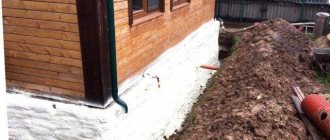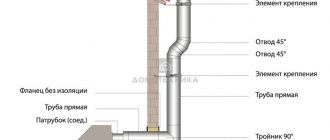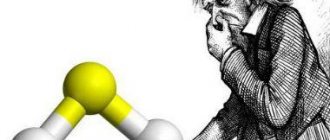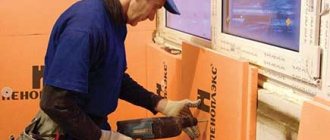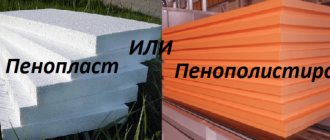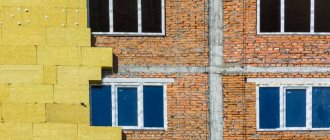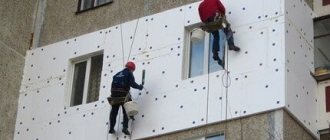Possibility of using foam fillers
Balloon thermal insulation , although better than its analogues in all respects, was not widely used in the past due to its high cost. And the use of such insulation was limited by the need to use special equipment, which, due to its price and complexity of development, is practically inaccessible outside the professional sphere. Much simpler and more profitable, although not always more convenient, was the use of mineral wool and polystyrene boards, which are made by extrusion.
Then manufacturers began to produce sprayed insulation in compact-sized cylinders, which led to a reduction in the cost of the method. To spray such a mixture of steel, complex installations and specialists in thermal insulation finishing are not needed, since the material itself is filled into small containers and the possibility of manual spraying is provided. Each cylinder is designed to cover one square meter of base (layer up to 60 mm thick). One person can process up to one hundred square meters per day.
As a result, calculations showed that working with insulation such as Polyno
r is much more profitable in terms of labor costs , costs for the materials themselves and surface preparation.
If a professional team of workers charges up to one and a half thousand rubles for insulating one square of wall, then using Polinor insulation with the same amount of material, you need to spend only about 500 rubles. You can work independently, which eliminates the need to look for experienced workers, reduces finishing time, and saves money. The choice of thermal insulation of this type remains the only optimal option that is available to people without special training. Foam can be used to create insulation for foundations, basements, walls inside and outside buildings made of brick, stone, concrete, and blocks. This option is also suitable for thermal insulation of non-load-bearing coatings, including floors on joists, as well as pitched roofs and attic floors.
Since Polinor is suitable for application to bases made of almost any material, it can be used as thermal insulation for plumbing fixtures and sewer pipes or fittings. In such cases, foam insulation in cylinders can be used indoors or in open areas. There is only one limitation on the use of balloon thermal insulation, which is that the material cannot be used to foam voids. It can only be applied to a dense base.
Where to use spray insulation
Due to compliance with safety standards, sprayed insulation can be used in public and residential buildings. The range of its application is quite universal:
- Roofing and attic structures
- Insulation of floors
- Insulation of wall surfaces
Objects can be classified as follows:
- Industrial buildings
- Outbuildings
- Refrigeration equipment
- Pipeline communications
- Vessels for technological purposes
Important to consider! Although spray-on insulation is considered environmentally friendly, thoughtful precautions must be taken when installing insulation in residential buildings. At the moment of application of the material, a polymerization reaction occurs, accompanied by a high degree of toxicity. And only after final hardening the risk of poisoning disappears completely.
And only after final hardening the risk of poisoning disappears completely.
As for the type of materials that can be used for insulation, there are no restrictions in this regard.
DIY spray insulation
Many owners of private houses, and even apartments, try to do all the work around the house with their own hands. But in this case, doing this without theoretical training and the necessary equipment is not easy.
In any case, for self-insulation with polyurethane foam you will need a balloon installation and the components necessary for this procedure, namely:
- Polyol, which must be mixed in a container with freon
- Isocyanate, also combined with Freon 134
Both cylinders must be inflated until the pressure in them reaches at least 8 atmospheres.
Next, spraying is carried out on the treated and prepared surface - just press the spray gun and direct a stream of insulation to the desired area.
Attention! When working independently with sprayed insulation, it is imperative to use personal protective equipment!
Sprayed insulation in cylinders
Since the independent process is not as complicated as its preparation, it will be easier to immediately resort to ready-made insulation kits in cylinders. In addition, there will be no noticeable difference in cost.
Sprayed insulation in cylinders is more practical, as it has been professionally prepared at the factory, including optimal pressure conditions.
Price for sprayed insulation
The cost of this insulation may seem slightly higher than materials in other categories. However, the economic efficiency of this thermal insulator is obvious when calculating, of course, the cost of other materials with the inclusion of additional equipment - profiles, sealants, fasteners and payment for the cost of professional work.
In the long term, the cost of insulation with sprayed insulation pays off by reducing energy costs.
Sprayed polyurethane insulation Polynor
An example of a successful choice of such insulation is Polynor insulation. Its advantages are evidenced by reviews of Polynor sprayed polyurethane insulation and instructions provided by the manufacturer in video format. The price for sprayed polyurethane insulation Polynor is identical to similar sprayed insulation in this category.
Thus, this type of thermal insulators is a priority in the choice of material for a number of technological indicators and for reasons of practical and budgetary value.
Material characteristics
Polyurethane foam (PPU) looks like a homogeneous structure of foam material, consisting of air bubbles filled with gas. Various versions of polyurethane foam are deservedly popular because they can be manufactured directly on the construction site. The most common method is to apply the material to the surface by spraying. Spraying is used for thermal insulation of houses, industrial workshops, pipelines, and in addition, it is actively used in the interior of premises.
Filling is used when it is necessary to fill a cavity between walls or a gap between installed finishing layers.
The thermal conductivity coefficient of the material is 0.023-0.025 W/mS. Teplis heat insulator is lightweight and can be easily applied to surfaces made of any materials (concrete, brick, glass, wood, aluminum, PVC).
Thanks to the optimal ratio of open and closed cells in the structure, the insulation “breathes”. Accordingly, the treated surface always remains clean and dry.
Other product benefits include:
- resistance to temperature changes;
- environmental friendliness;
- duration of operation (at least 20 years);
- seamless application, eliminating the formation of cold bridges;
- good sound insulation;
- low flammability;
- immunity from harmful rodents and insects.
Teplis polyurethane insulation is sold in 1 liter cylinders. Included with this product, the manufacturer offers to purchase a mounting gun with nozzles for uniform spraying.
Basement of a house with sprayed insulation applied
Key varieties
There are different types of urea foam. All of them are suitable for thermal insulation of buildings.
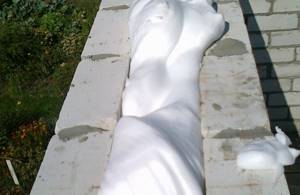
Penoizol can be used for thermal insulation of complex structures, interfloor ceilings and floors.
Main types:
- Liquid penoizol. Received the greatest distribution. It can be prepared directly on the construction site, which is why it is very convenient. The material is used for thermal insulation of various structures, as well as for repair purposes. Foam is poured into a confined space to form additional sound insulation in frame buildings. When it comes to repair work, penoizol in liquid form is used to fill cracks and gaps.
- Granular penoizol. It has several names: foam insulation crumb, thermal wool. It is available in the form of elastic granules. During manufacturing, the polymer is crushed into fractions up to 15 mm in size. The volume of the finished material after grinding doubles compared to the original amount. This is a good option to save on installation costs. Granular penoizol is used to fill the cavity between walls and for laying on the floor.
- Sheet foam insulation. The liquid material is poured into a special mold. After cooling, it is cut on special machines or simply by hand until it is given the required thickness. After this, they are dried and mechanically processed. The product is used to insulate buildings under construction. Installation is carried out with dowels from the outside of the walls. Decorative panels or siding are laid on top. In addition, the slabs are laid between the joists on the floor.
Read more: types of liquid insulation and application technology. More information about the production of penoizol:
Description and characteristics
Polinor is produced in a liquid state and applied to the surface by spraying. This popularity of the material is not caused by chance, because it is characterized by the following advantages:
- Fast drying. The surface becomes hard after 1 hour.
- Unaffected by rodents and insects.
- Does not form cold bridges.
- Does not harm the human body.
- There is no need to buy expensive equipment for application.
- The material is characterized by high efficiency.
- Has a long service life.
- The structure of the material is closed cells that do not allow water or steam to pass through.
- The material is self-extinguishing if there is no direct influence of fire.
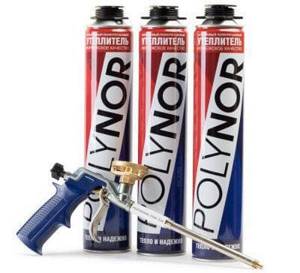
In the photo - liquid insulation in cylinders Polinor
Polinor is not without its disadvantages, which include:
- A surface made of Polinor is resistant to direct influence of UV rays and constant contact with water, and the process of applying the material must take place at a temperature of 15-25 degrees.
- When working with insulation, you must adhere to safety rules using a mask and respirator.
Compared to existing analogues of liquid thermal insulation for walls, Polinor insulation is significantly different. First of all, the changes concern the structure, or more precisely, the percentage of open and closed cells in the solid mass. This criterion is very important, as it affects the level of thermal conductivity, moisture absorption and water permeability. Using Polinor, you can get about 70% of the cells, while when using similar sprayed products, the number of closed-type cells will be only 30-40%. However, it cannot be used as a seal for interior doors.
On the video, liquid insulation in cylinders Polinor:
The material in question has the lowest thermal conductivity among all the insulation materials that are available on the domestic market today. For example, mineral wool has a thermal conductivity coefficient of 0.045, expanded polystyrene – 0.033, and Polinor – 0.023 W/m2* °C. Thanks to these properties of the heat insulator, it is possible to reduce its consumption. One cylinder will be enough to treat 1.2-2.0 m2.
Sprayed thermal insulator Polinor can be applied at temperatures from -25 to +125 °C. If it is exposed to a temperature of 450 degrees, then its length will be deformed by 85%, and damage by weight will be 50%. The duration of its independent combustion will be 5 minutes.
Polinor is an environmentally friendly insulation material, thanks to which it can be used when arranging a residential building. The material has high adhesive properties to various surfaces, resistance to moisture, chemicals and aggressive environments.
How to make urea liquid polystyrene foam penoizol with your own hands.
Description of liquid foam - penoizol.
Urea insulation is a foamed plastic consisting of 98% air and 2% urea-formaldehyde resin with approximately the same number of both open and closed pores. The structure of liquid foam is similar to the well-known soufflé type “Merringue”, and from a distance many people confuse it with expanded polystyrene (foam), but upon closer examination they recognize a completely different material from foam. Other names for insulation are mipore, liquid foam - penoizol, liquid insulation, urea foam, bipor and mettemplast.
Video: Appearance of liquid foam - penoizol and its mechanical properties.
Insulation with liquid foam plastic - penoizol.
— insulation of hollow walls: wooden frame houses, houses made of timber with insulation under the siding, hollow pockets in brickwork;
Video: Insulating the wall of a frame house with liquid foam - penoizol.
— insulation of floors, for example, if the house is on stilts with a ventilated underground;
— insulation of attics;
Video: Filling the floor and attic with liquid foam - penoizol.
- insulation of the attic roof;
— insulation of industrial refrigeration chambers and containers;
— insulation of industrial premises.
Production of urea liquid foam - penoizol.
It is quite simple to obtain liquid polystyrene foam - penoizol - it is a process consisting of several stages:
— Preparation of components: pouring resin and water into working containers, mixing the foaming agent and hardener with water, heating the water to 40 C;
— Filling the hydraulic system of the installation with resin and solution;
— Test pouring into a test container to control the quality of the insulation;
— Direct pouring of insulation into a building structure or mold.
Price for liquid polystyrene foam - penoizol.
The cost of raw materials for producing liquid foam - with 10th density at 2021 prices does not exceed 1000 rubles, even taking into account delivery.
Per cubic meter of 10-density
required:
15 l. resins*45 ruble liter = 675 rubles;
0.085 l. phosphoric acid * 120 rub/l = 10.2 rub;
0.170 l. foam concentrate ABSC * 160 rub/l = 27.2 rub.
Total: 712.4 rub/m3
Per cubic meter of 20-density liquid foam
required:
30 l. resins * 45 ruble liter = 1350 rubles;
0.085 l. phosphoric acid * 120 rub/l. = 10.2 rub;
0.170 l. ABSC foam concentrate * 160 rub/l. = 27.2 rub.
Total: 1387.4 rub/m3
One liter of resin contains 1.3 kg. The usual packaging is 200 liter barrels, approximately 260 kg per barrel.
One liter of phosphoric acid contains 1.75 kg. The usual packaging is 20 liter canisters, 35 kg each.
One liter of foaming agent ABSA contains 1.25 kg. The usual packaging is 20 liter canisters, 25 kg each.
For Siberia and the Far East:
LLC "Sibtem" Dealer, Nizhny Tagil
Novosibirsk, Prigranichnaya str. 3 (Pervomaisky district, Matveevka),
tel.8-913-923-30-72 Yuri Gennadievich
Supplies: Resin: Criterm, phosphoric acid, foaming agent ABSA
OJSC "UralKhimPlast"
Nizhny Tagil Northern Highway, 21. Supplied by: Criterm resin
Liquid foam
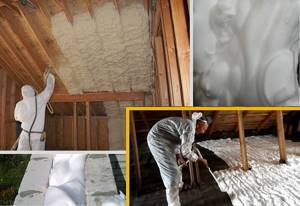
This type of insulation includes almost all foam materials based on polymer resins. The quality of the final product, including its environmental friendliness, largely depends on them. There are raw materials whose use is not permissible for residential premises due to the high toxicity of the polymer and its long-term emissions. At the same time, such materials are quite suitable for insulating technical structures or isolated building elements (if there is confidence in their insulation and the conscientiousness of the working specialists).
At the moment, such types of liquid foam as polyurethane foam, penoizol, as well as a number of products in compact cylinders are common.
Polyurethane foam (PPU)
Viscous heterochain polymers in a liquid state are used as the main component of this insulation. During chemical reactions, urethanes foam, which leads to their increase in volume by more than 50 times.
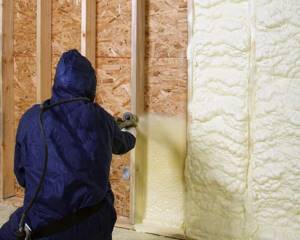
In its frozen state, polyurethane foam resembles ordinary polyurethane foam, the main difference in the structure is less porosity.
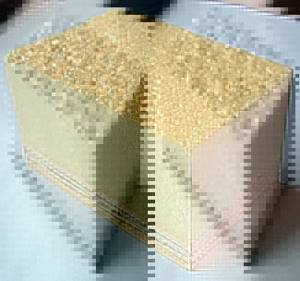
Mainly used for:
- Insulation of walls of frame buildings;
- Roofing structures;
- House facades;
- Thermal insulation of basements and lower floors.

To apply polyurethane foam, you need a special unit that first mixes and foams the insulation components, and then delivers the finished mixture under pressure to the surface to be treated.

Final polymerization occurs within 24 hours, after which the finishing can be installed. Polyurethane foam is suitable for treating surfaces made of brick, concrete, wood, metal, cinder blocks and gas silicate blocks.
The average cost of work including material is 1000-1500 rubles per m2 , with a layer thickness of 50 mm.
Penoizol
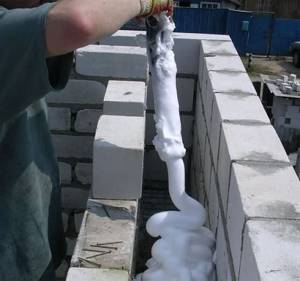
A budget analogue of polyurethane foam insulation, since it is based on relatively cheap, but more toxic urea-formaldehyde resin. The structure of this insulation is very similar to ordinary foam plastic, but its use is more preferable due to the absence of cold gaps in the insulating layer, characteristic of sheet and roll materials.
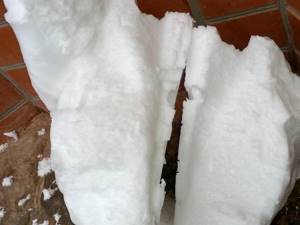
The density of penoizol, even in a liquid state, is noticeably lower than its urethane analogues, which does not allow its use in loaded structures. Otherwise, the scope of application is similar to polyurethane foam. Thermal insulation qualities are also not exceptional and are comparable to mineral wool, and two times less than that of the polyurethane foam described above.
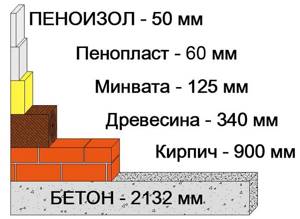
Apply under pressure after pre-mixing the components and foaming. Increases in volume by no more than 30 times relative to the original mixture.
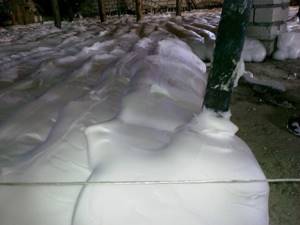
Roof insulation with foam insulation
Work together with the material costs approximately 2000 rubles per 1 cubic meter .
Polyurethane foam
The products are mainly used for processing seams between insulation elements. Polyurethane foam is relevant as a means for sealing structures; it is also used for fastening building and finishing materials to the base being constructed. In terms of operational characteristics, the resource has an average level of efficiency. Do-it-yourself polyurethane foam for insulating the walls of a house is produced in small containers; the products are presented in a wide variety of models. When applied, the composition expands 20 times. The material is easy to use independently; even an amateur can handle the job.
Polyurethane foam
Building materials in this category are attractive due to their versatility. Polyurethane foam as thermal insulation demonstrates a high level of efficiency. The PU foam composition has excellent properties of resistance to aggressive environmental influences. After foaming, the primary production volume increases 40 times. The presence of many microbubbles in a two-component compound determines the exceptionally low thermal conductivity coefficient of this foam insulation. The use of polyurethane foam for wall insulation involves significant costs, since the composition is applied using special equipment. The service life of polyurethane foam reaches 50 years.
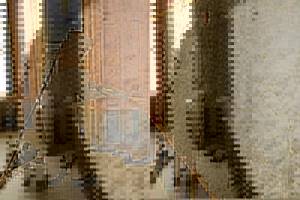
Polyurethane foam for wall insulation
"Polinor"
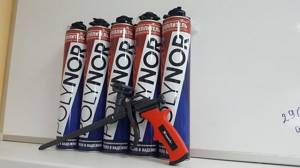
This is a liquid insulation based on polyurethanes. A common form of release is small cylinders, similar in appearance to those for polyurethane foam. Using one cylinder you can insulate about 1 m2 of surface with a layer thickness of 6-7 cm.
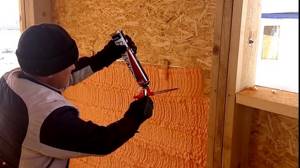
The strength and thermal insulation qualities are similar to polyurethane foam, but unlike it, “Polinor” is more suitable for household use, since it does not require special equipment for application. The relatively high cost (about 500 rubles per cylinder ) makes its use inappropriate over large areas.
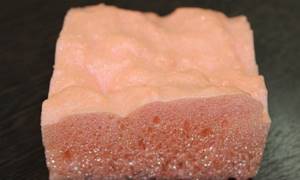
The insulation is applied by spraying, which allows it to be used on almost any surface, for example, for thermal insulation of pipelines located outdoors.
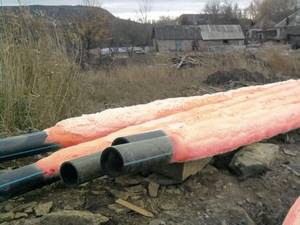
As for filling voids in the walls, this procedure cannot be completed due to insufficient pressure in the cylinder.
"Polinor" has the following technical characteristics:
- Thermal conductivity – 0.025 W/(m*K);
- Moisture absorption coefficient – no more than 0.03;
- No toxicity, non-flammable;
- Solid density – not less than 28 kg per m3;
- Retains all operational properties for 50 years;
- The operating temperature should not exceed +121°C;
In addition, the mixture is quite chemically stable and does not interact with most reagents common in everyday life.
Chloroform, dichloroethane, and high concentration hydrochloric acid have a negative effect (promote swelling) on Polinor. Nitric and sulfuric acids react with polyurethane, thus destroying the insulating mixture as a whole. Current prices for your city:
The use of penoizol for home insulation

Penoizol is produced by foaming urea-formaldehyde resin and its further polymerization. The convenience of this material lies in the fact that it is produced directly on the job site. Penoizol is supplied under pressure in liquid form onto the insulated surface, filling it with itself. Insulation with penoizol not only significantly saves effort and time, but also has a fairly reasonable price. At the same time, money is not spent on loading and unloading operations, transport services, fastening materials, and no space is needed for storing insulation.
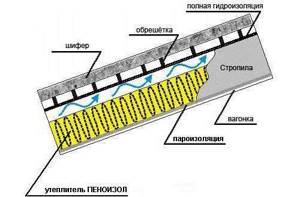
Scheme of roof insulation with foam insulation.
Differences and advantages of penoizol
- Penoizol differs from other materials in the peculiarity of its insulation work. The process is that a curtain façade is initially built, and then the cavity is filled with foam insulation under a steam-conducting membrane. This method can be used to insulate walls, attics, roofs and so on.
- Having low thermal conductivity, the material also has low bulk density. After drying, it has a fine-cell elastic structure and is absolutely odorless. Its air absorption is almost zero, it is not hygroscopic, fungal mold does not form on its surface, and mice do not eat this insulation.
- It is worth noting that you can work with penoizol only at a certain temperature; it should not be lower than 5°C.
- The material is environmentally friendly, for which manufacturers must have licenses and certificates. Penoizol is not only high-quality insulation, but also excellent sound insulation.
Insulation of houses with foam insulation
Wall insulation scheme.
To insulate a house, you will need a foam generator, with the help of which not only foam insulation is produced, but also it is directly poured or foamed. The technology for working with this insulation allows it to be poured almost anywhere. This material is very convenient because it can be used almost anywhere. They can:
- insulate loggias and balconies;
- fill the gap between the main wall and the drywall;
- pour under siding, wooden floors, panels;
- insulate the cavity of the internal and external walls.
It is very convenient to insulate ready-made, finished structures. For example, to fill voids in the walls it is not at all necessary to disassemble the structure; it is enough to drill several holes taking into account the diameter of the steam generator hose and fill the voids with foam insulation through them. In such cases, experts recommend filling from the bottom up.
For this job you will need very few materials and tools.
The best manufacturers of polyurethane foam
The ranking of well-known manufacturers of polyurethane foam is headed by brands that have earned recognition in the construction industry.
Soudal
The brand has factories in Poland, Belgium and Slovenia. Soudal brand products provide a structure that meets high European standards and a good yield volume. The sealant does not darken or deform over time, and the durability of the product is impressive.
Krimelte
The manufacturer from Estonia (Penosil brand) offers a variety of models of polyurethane foam for various purposes. Krimelte products are known in the professional environment for their decent price-quality ratio.
Titan
The Orion brand, with production facilities in Turkey, Spain and Poland, ranks third in the popularity rating among polyurethane foam suppliers. Products of this brand foam well without secondary expansion.
Moment of installation
The products of a well-known brand are in demand due to their decent quality and availability of solutions.
Ultima
The brand produces good quality polyurethane foam, the products are easy to use. Judging by consumer reviews, the sealant of this brand does not have an acceptable level of efficiency.
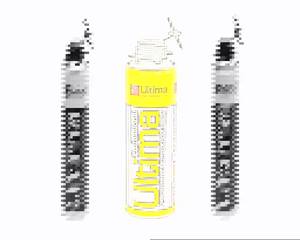
Foam for wall insulation
Axton
The company produces a sealant with high odorless polymerization characteristics, while reviews indicate low adhesion and high porosity of the structure.
Titan02
The highly popular mounting foam Titan02 is available in a winter version and with increased fire resistance. The product demonstrates exceptionally high efficiency when installing window and door structures. It is actively used in the repair of utility systems, sealing and thermal insulation of buildings. Titan02 sealant is sold within 230 rubles.
Penosil
The product is distinguished by its density and uniformity of structure with a large output volume. It is used for installation of structures, filling seams and cavities of varying complexity. The model range also includes special versions for foam plastic. The cost varies from 220 rub.
Insulation materials
0 votes
+
Vote for!
—
Vote against!
The use of liquid foam as insulation has many advantages, among which, first of all, it should be noted its ability to fill the smallest cracks. In addition, the cost of this insulation is quite affordable compared to alternative options. We’ll talk about the features and scope of liquid foam further.
Table of contents:
- Liquid foam: features and characteristics
- Liquid foam insulation - scope of use
- Advantages of wall insulation with liquid foam
- Insulation of houses with liquid foam plastic - technology and properties
- Liquid foam manufacturing technology
Liquid foam: features and characteristics
The production of polystyrene foam is based on the use of a resin of a polymer composition. There are a large number of varieties of this material, which distinguish:
- by purpose - technical type foam is more harmful to the environment, it contains toxic substances, foam installed in residential premises has a different composition, which is absolutely harmless and has a good degree of cleaning;
- According to manufacturing technology, materials based on already hardened foam are safer; when working with liquid foam, there is a risk of releasing harmful substances during the process of its hardening.
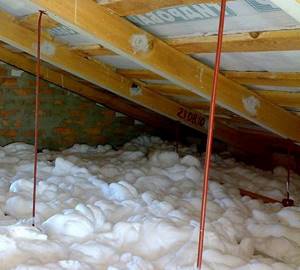
The most optimal version of liquid foam is made on the basis of urea-formaldehyde resins.
Each of the insulation materials that have a foamed purpose is formed by hardening the material from which it is made. If the foam is applied directly to the surface that needs to be insulated, then its adhesion to it increases several times than if a foam slab is installed on the same surface.
To prepare liquid foam you will need a resin and a hardener. A special machine mixes and beats all the ingredients into a homogeneous foamy structure. Next, it is supplied using a pump and a hose directly to the insulation object.
There are special units that deal with this process. Although it is possible to make your own device, which is responsible for preparing liquid foam. The cost of purchased devices is quite high and reaches more than $3,000. To assemble such a device yourself, you will need much less money.
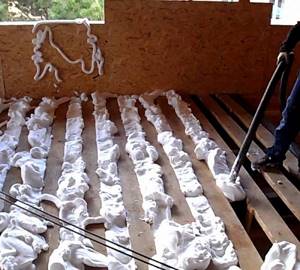
Purchased liquid foam is produced in the form of a balloon. After the foam hits the wall surface, it instantly hardens and becomes an excellent insulation material.
Among the advantages of liquid foam are:
1. Excellent level of adhesion with almost any materials.
2. There is no need to prepare the surface before laying foam.
3. Formation of a seamless perfect seam that does not allow heat to pass through.
4. Excellent vapor permeability, which allows you to maintain a healthy indoor microclimate.
5. Used for insulating surfaces of various compositions: concrete, brick, wood, etc.
6. Liquid foam can fill all the space that requires insulation.
7. Absence or easy removal of excess and smudges.
8. Environmental friendliness and harmlessness to human health is ensured if a high-quality type of foam is chosen.
9. Affordable cost, which is several times lower than alternative insulation in the form of mineral wool.
10. Good resistance to mold, mildew and microorganisms.
11. Ability to function in different temperature conditions. Resistant to temperature changes.
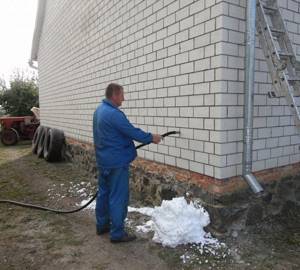
Despite this, liquid foam has certain disadvantages, namely:
- the possibility of linear shrinkage, which appears if the foam was poured without the required pressure;
- the presence of an unpleasant odor that disappears over time;
- ability to absorb moisture, so the material should be protected from external influences on both sides;
- due to the presence of formaldehyde, it is recommended for use as an outer layer of insulation or as an intermediate layer.
Liquid foam insulation - scope of use
Liquid foam plastic has limited use indoors, but is still widely used in the process of insulating horizontal planes, such as the attic floors of a panel house. In addition, it does an excellent job of insulating the space between the rafters and inclined areas.
Due to the presence of a liquid consistency, polystyrene foam perfectly insulates the space between two sections of walls that fit tightly to each other. It is used to insulate formwork, false walls or floors made of wood.
Liquid foam is able to penetrate into the most remote areas of the walls. With its help, they are filled evenly and efficiently.
The use of liquid foam is associated with the insulation of containers. In addition, the unit with which insulation is produced is also used for the manufacture of any kind of foam products, such as skirting boards, baguettes, slabs, relief elements, etc.
Please note that all materials used in the liquid foam manufacturing process should be carefully checked. Since there are many scammers or pseudo-factories that produce liquid foam at a low cost. In this case, a low-quality hardener is used, which is not only harmful, but also dangerous to human health.
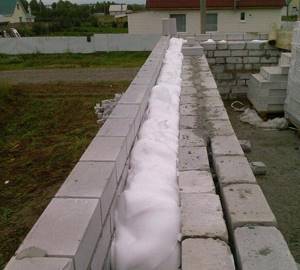
Liquid foam in containers is used as glue. In terms of shape and application, it has similar properties to polyurethane foam, although in comparison it has higher thermal conductivity and vapor permeability.
It is suitable for fixing various types of insulation boards on the surface. To do this, you must follow the instructions:
1. Make sure there are no defects on the surface. It should be smooth, without rust spots, cracks or chips.
2. Clean and dust the surface.
3. In places where the glue comes into contact with the board, water should be applied to improve their adhesion.
4. The option of applying polystyrene foam to the entire surface is possible. If you plan to save money, then it is applied only in horizontal and diagonal directions.
5. Once the liquid foam is applied to the surface of the slab, it should be pressed firmly against the wall.
6. Further slabs are laid in the same way.
Please note that thermal insulation using foam plastic, in the absence of a properly organized ventilation system, leads to the formation of condensation masses.
Application of liquid foam does not require careful surface preparation. This is what explains its wide popularity. When using a special installation that produces foam plastic, insulation requires only water and electricity. The foam is applied using a hose, the size of which is limited by the distance from the unit that produces the foam to the place of insulation.

Liquid urea foam is used in the following cases:
- internal work on gluing various kinds of structural elements for thermal insulation of bathrooms, in order to ensure sound insulation;
- when carrying out external work - façade insulation, waterproofing, installation of blocks made of concrete, etc.
Using liquid foam is quite simple. Before applying it, the surface should be cleaned of dirt and dust, and water should be applied to it to improve the adhesion of the foam. It is better to carry out work at a temperature of about twenty degrees Celsius. If the air temperature is lower, then the finished mixture is heated with warm water. If the weather is too hot, then the mixture is cooled using the same method.
Before using purchased liquid foam, you should first shake the container in which it is located about 10-15 times. Thus, there will be an even distribution of the material inside the cylinder.

Advantages of wall insulation with liquid foam
If polystyrene foam is produced directly at the site where construction work is being carried out, then its quality is much lower than that of balloon liquid foam. The use of purchased polystyrene foam, which is sold in balloon form, has the following advantages:
- durability;
- environmentally friendly and harmless to health, provided that the foam is made of high-quality materials;
- fire safety and fire resistance;
- resistance to biological influences;
- resistance to insects and rodents.
Liquid foam insulation has an excellent ratio of cost and quality of thermal insulation material. It is capable of insulating both already erected walls and structures that are under construction. In addition, liquid foam differs:
- excellent thermal insulation characteristics;
- high technology use;
- service life of 45 years;
- resistance to high temperatures;
- affordable cost;
- fire safety;
- high density;
- good soundproofing characteristics.
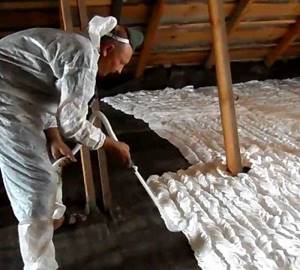
Insulation of houses with liquid foam plastic - technology and properties
Filling with liquid foam is carried out directly at the construction site, so insulation work is done quickly and easily. Penoizol is not prone to expansion, but is still characterized by the presence of slight shrinkage. To avoid the appearance of cracks that form as a result of shrinkage, you should strictly follow the technology of filling with penoizol.
The material must be proven and high quality. The minimum temperature for work is six degrees. If you are using a purchased type of foam, you should first study the instructions for working with it.
Sometimes slab or tiny materials are used. Since foam in a dry state is excellent for any surface. After pouring, a seamless layer is formed with excellent heat and sound insulation characteristics. This design practically does not allow moisture to pass through, despite the presence of small cracks in it.
The use of liquid foam is associated with insulation:
- fencing for external purposes;
- insulation of walls of simple or combined composition;
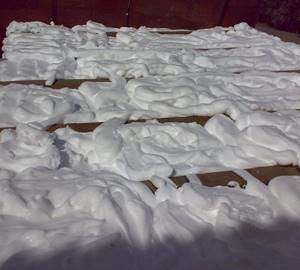
- thermal insulation construction made of bricks consisting of three layers;
- filling panels made of reinforced concrete;
- ensuring sound insulation and sound absorption;
- as insulation in laminated panels;
- interfloor insulation;
- insulation of roofs, attics, attics and balcony structures;
- insulation of garages, boxes, outbuildings, hangars, open areas, etc.;
- thermal insulation of cottages, basements, vegetable stores;
- thermal insulation and sound insulation of wall panels, which are installed on a frame made of both metal and wood;
- soil insulation.

Liquid foam manufacturing technology
To buy liquid foam, you should contact the manufacturers directly. They must be verified in advance with all the documents necessary for the work. In addition, you should worry about the availability of certificates confirming the quality of the products.
The price of purchased liquid foam is higher, so the process of making it yourself is several times cheaper.
With the help of properly made liquid foam, you can complete all the work efficiently, quickly and efficiently.
The procedure for making liquid foam involves mixing water foam with urea resin and a hardener. Next comes polymerization, that is, solidification of the finished substance.
After drying is completed, the material takes the form of foam plastic that is familiar to us. Polystyrene foam is applied to the surface in the form of thick foam, which has a thick consistency. It insulates various types of building structures well. In order to fill all the air gaps, a certain pressure must be supplied under which the foam is supplied.
Next, the material hardens and begins to function as insulation. A house properly insulated with liquid polystyrene foam requires several times less heating costs than a building without insulation.
Work should begin by directly pouring the material onto the surface. To obtain high-quality material, you should adhere to a certain technology for installing liquid foam.
Insulating a house with a total area of 70 square meters will require about six hours of work. If you hire specialists who do insulation using liquid foam, the cost of the work will be about $25 per square meter. Independent insulation will reduce costs by two or even three times.
Liquid foam insulation involves pouring liquid foam into all empty areas of the walls. This procedure is carried out by pre-drilling holes into which the hose is inserted. It is the pressure that ensures that the material adheres tightly to the wall, filling all cavities and eliminating cracks.
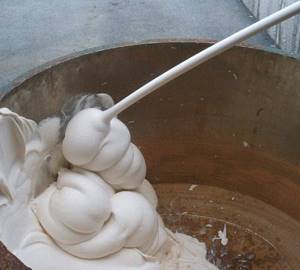
Subject to the correct manufacturing of liquid foam and its application, the use of this material as insulation allows you to obtain high-quality, inexpensive and effective insulation.
Liquid foam video:
Receiving PPU
When mixed, polyol and isocyanate produce foam, which increases in volume and then hardens. During the manufacturing process, it is necessary to adhere to a number of requirements: maintain the required temperature and mix all components well, which makes it possible to obtain a polyurethane output that does not have seals and large air cavities.
If you change the production method, you get polyurethane foams that differ in their basic characteristics. Some are better suited for insulating openings for doors and windows, others for brick and panel buildings or pipelines. By changing the proportions of the ingredients, when mixing them, polyurethane foam with different cell sizes is obtained.
The most popular materials in this group are the following:
- Foam rubber. It is widely used in everyday life and is familiar to every person. It is used as an upholstery filler for upholstered furniture and lining material.
- Rigid polyurethane foam is used when performing installation work. It has been noticed that this insulation is negatively affected by acids and solvents.
Features of liquid penoizol
Another contender for wall insulation is liquid penoizol. This material is capable of surpassing mineral wool and expanded polystyrene in its technical characteristics. The basis of the raw material is foamed and hardened urea resin.
Penoizol is included in the average price range on the building materials market, which is why it is so popular among wall insulation specialists. The use of raw materials has been echoed since the 30s of the last century, but then foam insulation insulation was not in demand due to its high cost. It is also possible to produce the material on the construction site.
Penoizol for wall insulation
This raw material is often used as a frame filler between the inner and outer surfaces of the wall. But thanks to its good performance, penoizol can be used for placement on a vertical wall.
Several main characteristics of this material:
- does not increase in volume;
- It is a soufflé-like mass, similar to foam;
- used for insulating walls and floors;
- lasts about 50 years;
- low water absorption.
Penoizol is used in external walls and partitions of houses made of wood and reinforced concrete; in buildings that are subject to repeated dismantling, as well as in roofing panels.
The cost of liquid penoizol depends on the brand. For example, in advertisements you can often find direct prices for pouring material - from 1,500 rubles per 1 cubic meter. meter. At the same time, some manufacturers offer components for the independent production of penoizol - VPSG resin, ABSPA and orthophosphoric acid.
DIY application technology
Applying liquid insulation does not require any professional skills or expensive equipment (with the exception of liquid foam). To work, you will need a roller (brush or spray). When using a roller, you will also need a container to evenly rub the mixture over its surface. The process itself includes the following steps:
- We prepare the surface (clean the walls from excess mortar, sweep with a brush and wash with water).
- We prepare the material (if necessary, dilute it to the desired consistency).
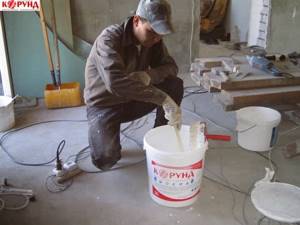
- Pour paint into the roller container.
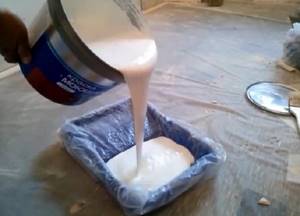
- Dip the roller in paint and roll it out on a special area until the mixture evenly saturates the roller.
- We carefully apply the insulation to the wall, no need to press hard. The first layer is applied from bottom to top.

- Subsequent layers are applied after complete polymerization of the first, usually after 24 hours (to find out the exact values, see the instructions for the insulation).
When drying any of the layers, it is necessary to avoid getting them wet, since most liquid thermal insulators are water soluble. Because of this, the impact of water on insulation that has not completely hardened can cause its complete or partial removal from the surface.
Application technology - video instructions:
Consumption per 1 m2
As noted in the advantages, this insulation is quite economical. The consumption of polyurethane foam in cylinders is as follows: 1 liter is enough to cover a wall of 1 m2 with a layer 4 cm thick. For comparison, when working with mineral wool, you will need to spend more. In addition to the material, additional elements are needed for insulation, that is, sheathing, fasteners, etc., which also costs money.
Required layer thickness
It all depends on the region in which the object is located. For clarity, there is a table that indicates how thick the layer should be for a specific element.
The main nuances of self-insulation of walls
The process of insulating walls with your own hands using the specified material is best done together with another assistant. You can mix penoizol directly at the construction site or purchase liquid foam in cylinders. If liquid ceramic insulation is used, one person can handle it.
Self-insulation of walls with liquid material
Do-it-yourself insulation will cost several times less, because the costs will only go to materials and necessary tools. The cost of insulation in the vastness of the country varies depending on the complexity of the work and the type of material:
- up to 10 cubic meters, filling the walls of structures with liquid material will cost from 20,000 rubles;
- from 10 cubic meters the cost varies, it will be from 1500 rubles per cubic meter.
As can be seen from the prices, you can carry out insulation yourself: for this you will need to select the necessary tools and materials, as well as study the step-by-step algorithm of work.
Preparation of tools and materials
The production of insulation material can be carried out at a construction site, for this it is necessary to purchase a special installation in advance. All the components necessary for the production of insulation are placed in it, air is supplied and the process of forming penoizol or polystyrene foam is carried out.
The cost of such an installation starts from 20 thousand rubles, it can also be rented. If such a move is not profitable, and the area for insulation is small, you can use ready-made insulation in cylinders.
Equipment for applying insulation
Before you start work, you need to prepare:
- electric hammer drill;
- drills with pobedite tips;
- wooden pegs of the appropriate size for temporary plugging of holes;
- container or unit with liquid foam.
Depending on the type of coating, the appropriate insulation is selected. When insulating external walls, it is better to work with a partner: one person turns on the device, the other monitors the flow of foam into the hole. When filling the hole, a wooden wedge is inserted into it, and the unit with a hose is inserted into another hole.
Step-by-step algorithm of work
Initially, you need to calculate the amount of material. This is done according to the formula V (volume) = wall length x wall height x thickness of the future layer.
By calculating the volume of material, you can calculate the approximate total cost, taking as a basis the price of 70-80 rubles per square of insulation.
It is better to carry out the work process together with a partner
Instructions for self-insulation:
- Insulation of the internal wall. Finishes made of corrugated board or plasterboard serve as partitions for cells. The surface is thoroughly cleaned of dust. Filling starts from bottom to top. As the penoizol is filled, it begins to harden within 20 minutes.
- Filling the outer wall with insulation. First you need to drill holes in the wall - if it is brickwork, they are drilled in the firmware. Then a pipe with a hose according to the size of the hole is inserted, and the material is pumped into it. Before pumping, it is advisable to check the holes with air for dead spots.
Insulation of walls with liquid insulation is considered the most popular procedure for thermal insulation of external and internal surfaces. High quality material, excellent operating speed and durability play a decisive role when choosing the type of insulation.
Features of insulation application technology
The technology for installing sprayed insulation in cylinders involves the following steps:
- the cylinder is equipped with a special tube or gun, having first removed the lid;
- shake the composition thoroughly for at least 60 seconds;
- before applying foam thermal insulation, the surface is treated with water;
- The cylinder is held with the bottom up, the voids are filled to 1/3 of the volume, leaving room for expansion of the composition.
When the foam fills the entire volume of the gap, it is recommended to sprinkle the mass with water to improve the polymerization process. Curing time for foam insulation varies depending on the model and brand, and manufacturers produce products of varying quality. Surface hardening is observed within approximately 20 minutes after spraying. Correction of the mass using a cutting tool begins no earlier than after 4 hours. The full period of polymerization of foam floor insulation in cylinders requires a period of at least 24 hours.
Providing protective equipment
When applying polyurethane foam in cylinders for floor insulation, it is worth considering that the composition is poorly washed off from skin and clothing. You should work in protective clothing; it is also important to use safety glasses and gloves. Manipulations of spraying polyurethane foam with special equipment are performed using professional equipment to completely eliminate contact of the skin and mucous membranes with the substance.
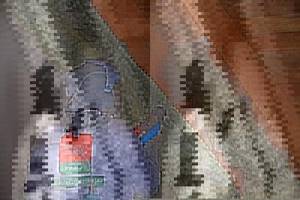
When insulating a floor with foam, you need to use protective equipment
Thermal insulation of the floor by spraying
Installation of polyurethane foam when insulating floors using spraying technology involves the use of special installations. The foam insulator components are contained in separate tanks. The working composition is prepared directly on site before use. Substances enter the mixing device, are then sent to a spray gun and applied under pressure to the surface to be treated.
Features of installation of foam insulation:
- a frame structure is constructed for applying spray-on thermal insulation. Experts recommend lathing depending on the nature of the area being treated. For example, for effective thermal insulation of a wall structure, it is advisable to build a wooden or metal frame with an interval between guides of 30 cm. If you plan to insulate the floor with sprayed polyurethane foam, you should create a sheathing in increments of up to 1 m;
- the foam composition is applied by smoothly moving the jet over the surface to ensure uniform distribution of the mass;
- when processing vertical planes, foam insulator is sprayed from the lower perimeter, gradually filling the openings upward;
- When manipulating, keep the spray gun at a distance of at least 25 cm from the surface to be treated. When moving to another sector, you must release the gun trigger to block the stream.
If you plan to insulate the floor with two-layer spray foam, it is necessary to allow time for complete polymerization of the previous layer. After the mass has hardened, adjustments begin: cut off all protruding fragments with a sharp knife and level out any unevenness.
The flooring is laid after the foam insulation has completely polymerized.
Floor insulation by pouring method
The technology involves creating monolithic thermal insulation in the floor structure by pouring foam into specially made cavities. For example, a rough plank floor is constructed on joists, and small holes are made on the surface in designated areas for pumping polyurethane foam. If thermal protection of walls is planned by pouring polyurethane foam, the cladding is performed with a technical gap between the base and the finishing material. Next, the foam composition is poured through special holes on the facing panel.
Filling is carried out on the basis of the same spraying installations, reconfiguring the equipment parameters. In a professional environment, special units are also used for pouring polyurethane foam, which determines the high-quality level of thermal insulation work. The foam substance exclusively fills all voids down to the slightest cracks, resulting in the formation of a sealed thermal barrier with high performance characteristics.
Material preparation technology
Liquid foam is prepared immediately before its use.
But this will require special installations, since nothing can be prepared manually. This is a special ejector and foam generating unit. The main component is a resin-glue, which, when interacting with a hardener under temperature, turns into plastic.
In addition to all this, you will definitely need a foaming agent and definitely water. The previously obtained solution is fed into the foam generator for foaming and after that the foam should harden for the first time within 20 minutes. Complete hardening and drying occurs in approximately 3-4 hours. Externally, the result is a porous surface that does not allow liquid to pass through.
Many argue that liquid insulation absorbs a lot of moisture and cannot be used as an external cladding material for private houses or large public buildings. But this is absolutely not true, because its basis is precisely intended for such use. Moreover, during testing and inspection of this material, it was found that when exposed to strong moisture and even basic contact with water, the humidity of the liquid foam itself does not exceed 2%.
This indicator does not change no matter the weather. Even if it is not possible to order installation of insulation, such devices for preparing the solution can be easily purchased in a store or simply rented.
If this is a private house of normal size or even a two-story one, then small installations will do. The insulation process will not take much time if you have all the necessary components and all the building materials.
Which liquid insulation to choose?
As is known, long-term or improper storage significantly worsens the properties of materials, especially liquid insulation. In this regard, when choosing a composition, you should first of all pay attention to the date of its manufacture. In addition, it is recommended to give preference to well-known brands that have proven themselves, because the effectiveness of the entire thermal insulation system depends on the quality of the liquid insulation.
In order to ensure the quality of liquid insulation produced in the form of paint, experts recommend:
- Check the weight of the bucket - the lower the density of the composition, the higher its heat-saving properties. Therefore, if a ten-liter plastic bucket weighs more than 6.5 kilograms, then you should not purchase such a composition.
- Check the paint against light, as light microspheres rise up. Therefore, the thicker the top layer of insulation, the better its thermal insulation characteristics.
- Rub a small amount of paint with your fingertips - a good material should feel a large number of rough microgranules. The absence of such an effect indicates low quality of the product.
- Make sure the composition is white - a change in color indicates gross violations of the technological process. However, this rule does not apply to paints with mineral color additives.
It should be noted that in this case you should not focus on the cost of the product, since some manufacturers deliberately sell low-quality products at inflated prices in the hope that the choice stereotype will be triggered.
Features of using polystyrene foam as insulation
When securing material from the warm air side, special attention should be paid to safety. It is worth considering several disadvantages of wall insulation with polystyrene foam, which can be combated at the construction or repair stage
These disadvantages include:
- flammability;
- low vapor permeability;
- the need for additional vapor barrier;
- the likelihood of a greenhouse effect occurring indoors with insufficient ventilation.
To prevent the risk of fire, strict compliance with all fire regulations is required. When choosing a material for thermal insulation of the walls of a house from the inside with your own hands, you should give preference to those types that are highly resistant to fire. The flammability group is indicated by the letters:
- NG - non-flammable;
- from G1 to G4 - varying degrees of flammability.
The higher the number on the label, the more dangerous the material is offered. In the store, it is recommended to choose the foam that has the lowest degree of flammability of all those presented. You can additionally consult with the seller.
To prevent the appearance of mold and mildew on the walls, it is necessary to move the point of condensation from the surface of the connection between the wall and the insulation. The thermal insulation material is attached to the wall from the inside with your own hands without any gaps. This way you can avoid problems with condensation.
The most important task when using polystyrene foam as a heat insulator is to ensure the necessary air exchange. If there is insufficient ventilation of the premises of the house, the microclimate is disrupted. There may be problems with humidity and indoor air temperature. To prevent troubles, you need to think about ventilation at the building design stage.
To prevent condensation, use the following techniques (simultaneously):
- a small ventilation gap is provided between the wall insulation and the interior decoration;
- a vapor barrier is attached on top of the insulation;
- carry out measures to install a forced air ventilation system.

If you take into account all the features of foam plastic as a building material, you can use it for the wall of a house without fear. Installing thermal insulation with your own hands requires attention to every detail and adherence to the technology for performing the work.
Advantages and disadvantages of liquid insulation
Among the positive qualities are the following:
- Possibility of application to surfaces with almost any relief;
- Resistance to atmospheric factors;
- Low cost of installation work;
- Liquid insulation forms a monolithic layer, without joints that occur when using sheet materials.
- There is no need to coordinate the insulation with the supervisory authorities, since after application the appearance of the building remains unchanged;
- The high adhesive properties of liquid insulators eliminate the need for careful surface preparation;
Flaws:
- If storage and transportation rules are not followed, there is a high probability of premature loss of the mixture’s performance qualities;
- Short service life compared to traditional insulation;
- High cost of some products;
- Many foam materials cannot be applied without special equipment;
What is liquid wall insulation
Today there are a lot of manufacturers who specialize in the production of liquid insulation.
Using this material you can solve a number of problems, including:
- Correct exchange of thermal energy, thanks to which the house can be found in time in winter and not overheat during the heat.
- The structure receives reliable protection from moisture.
- There is no formation of mold and fungi.
- The house is protected from external corrosion.
- Liquid heat insulator prevents condensation from forming in the corners of the house.
- The material can reduce heating costs in winter.
The consistency of the building material resembles thick paint. Its color is white, but to obtain a boring shade, you can add various colors to the composition. Liquid insulation for walls is a modern solution, thanks to which you can get excellent results directly in retaining heat and giving the building an attractive appearance. In addition, there is no need to additionally select disc dowels for attaching the insulation.
These insulation materials for the interior walls of a house have high quality characteristics, and the presence of a paste-like structure allows you to create high-quality protection for the walls. Thanks to its liquid consistency, the insulation can be evenly and quickly distributed over the surface and poured into hard-to-reach places.
Application
It is allowed to use Polinor insulation both inside and outside the house. At the same time, make sure that it is not directly affected by sunlight and moisture. The installation process is very simple and quick, and even an inexperienced person can cope with the task. All that is required is to install the container on the spray foam gun.
But before this, it is important to properly prepare the surface. It must be cleaned of dust, dirt and moistened with water. The process of applying foam is performed with smooth movements, without jerking. Thanks to this, you can obtain a uniform layer of insulation. Polymerization occurs through reaction with moisture. If you additionally moisten the surface, the composition will be more voluminous. Rubber door seals can provide additional insulation.
Video showing the use of sprayed polyurethane insulation polynor:
In addition, the material becomes lush even at a temperature of 20 degrees. But at a temperature of 15 degrees, the composition becomes dense. The material can be applied both to the frame and to the wall. The choice of a particular method depends on the subsequent cladding.
The following options are provided:
- applying paint;
- applying a layer of plaster;
- use of drywall, OSB, lining, siding.
Polynor insulation is sprayed on in several layers. It can be used not only for thermal insulation of walls, but also floors and roofs. It is often used when insulating various metal tanks and communications.
The sprayed composition is able to pass through all cracks and hard-to-reach places, forming a monolithic seamless layer. It will not allow heat, steam and moisture to pass through. The material should only be applied with gloves and safety glasses, as it has a strong and pungent odor. It is very difficult to be in an unventilated room, but after installation the smell disappears very quickly.
You may also be interested in learning about which insulation for external walls under plaster is best to use.
But this information will help you understand what a wall pie of a frame house with basalt insulation is and in what cases it is used.
What are the characteristics of mineral wool insulation and where can it be used and how exactly. This video explains it in great detail.
And this information will help compare the thermal conductivity of insulation materials.
This article will help you understand what Energoflex water supply pipe insulation is and where it is most often used.
Material selection
The quality and effectiveness of the insulation of the walls of the house will depend on the correct choice of thermal insulation material.
When insulating externally, it is necessary to pay attention to the following factors, which will directly determine the choice of material used:
- Chemical resistance.
- Fire safety and fire resistance.
- Ecological cleanliness.
- Sound absorption indicators.
- Minimal vapor permeability and moisture absorption.
- Low thermal conductivity coefficient.
- Durability and strength.
- Resistance to biological factors and mechanical stress.
- A light weight.
- Ease of installation.
Having correctly selected the insulation used, all work on wall insulation can be done independently, subsequently lining the facade of the building with siding panels, a block house, plastering and painting the walls of the house.
The most commonly used types of insulation for external walls are:
- Liquid thermal insulation.
- Basalt materials.
- Mineral wool.
- Polyurethane foam.
- Extruded polystyrene foam.
- Styrofoam.
Each of these thermal insulation materials popular with homeowners has its own advantages and disadvantages. The technology of working with one or another insulation also differs, which must be taken into account when renovating a house.
Polystyrene foam insulation
Expanded polystyrene (foam) is an inexpensive polymer insulation for house walls, which is efficient and affordable. This material is characterized by low thermal conductivity, minimal water absorption and resistance to chemical and biological influences. Modern foam plastic is an environmentally friendly, inexpensive and durable material, the service life of which exceeds 50 years.
Using expanded polystyrene does not present any difficulty; the insulation sheets can be fixed with glue or with dowels with mushroom caps. Among the advantages of this material, we note the ease of working with it: insulation with polystyrene foam can be carried out even without installing additional sheathing; there is no need to use steam and waterproofing materials.
Extruded polystyrene foam
This is the latest generation of insulation, which differs from polystyrene foam in improved strength and excellent thermal insulation characteristics. Extruded polystyrene foam is resistant to chemicals, is not susceptible to mold, is not eaten by rodents and insects, and is at the same time an excellent sound insulator. The excellent environmental friendliness of this insulation allows it to be used for external and internal insulation.
Features of polyurethane foam
Polyurethane foam is an inexpensive and easy-to-use insulation material that has a cellular foam structure. Excellent adhesion of polyurethane foam to metal, wood, brick and concrete surfaces ensures high-quality thermal insulation and good sound and thermal insulation performance.
Polyurethane foam is applied to the walls of the house using a compressor with a hose, which ensures uniformity of the coating and the absence of seams. The excellent elasticity of the material when applied makes polyurethane foam one of the best thermal insulators for insulating the walls of buildings of complex shape, when it is not possible to use conventional slab and roll insulators.
Mineral wool
Mineral wool is a natural, environmentally friendly insulation material that is obtained from dolomite, basalt or by recycling waste from the metallurgical industry. This insulation is characterized by durability, environmental friendliness, strength, good sound and thermal insulation of the room. Mineral wool is used for internal and external insulation. In the latter case, it will be necessary to ensure high-quality protection of the coating from moisture, for which moisture and vapor barrier membranes are used.
Liquid thermal insulation
Liquid heat insulators are new generation materials that can be used with equal success for private houses built from wood, blocks and bricks. Such liquid thermal insulation can be applied using rollers or brushes, spray guns or high-pressure compressors. It takes 5-6 hours for the material to dry, after which the coating acquires the necessary strength and resistance to mechanical stress.
https://youtube.com/watch?v=nuYTNizJJPo
Consumer properties
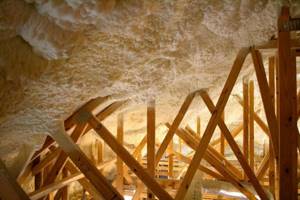
Like any insulating material, Polynor has a number of advantages:
- Features excellent heat conservation. These insulation indicators are higher compared to expanded polystyrene and mineral wool.
- Non-toxic. Consumer reviews about Polinor are quite good, since it is not poisonous and does not require protective equipment when using it.
- Ease of use. When using POLYNOR, a heat-insulating layer is created, which does not require a frame for fastening. Also, no tools or auxiliary materials are required.
- Excellent grip. The composition quickly adheres to any surface - brick, wood, plastic, stone, concrete, which significantly expands the scope of its application.
Polynor insulation is very popular due to the fact that it is applied by spraying. This affects better adhesion of different surfaces, even if they are not very smooth. Very often this insulation is used to finish hard-to-reach places, for example, where pipes or cables are laid.
Liquid polystyrene foam
Liquid polystyrene foam has a lot of names: they are assigned by the direct manufacturers. The most common names for this material are “unipol”, “mettemplast” and “penoizol”.
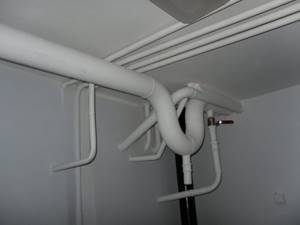
Liquid foam composition:
- Urea-formaldehyde resin (often contained in cold-curing foams).
- Foaming agent.
- Orthophosphoric acid.
- Water.
The percentage of resin affects the degree of density of the insulation. To mix the ingredients, a special gas-liquid apparatus powered by compressed air is used. As a result, all components of the composition are brought to the state of voluminous saturated foam.
Characteristics and features of penoizol
The technical process of insulation with penoizol is attractive because the thermal insulator is produced directly on site. The original type of penoizol is liquid foam (liquid foam) poured under high pressure into the insulated openings.
The foam fills all the cavities, hardens, and produces excellent insulation. This technology is quite practical and economical, and the insulation itself is relatively inexpensive.
The manufacturing procedure involves mixing urea substances with water and hardeners. Then the process of polymerization (solidification) occurs. As a result, penoizol insulation resembles fine-cell foam.
Thermoactive resins used in manufacturing, having reached a solid state, are not able to turn back into a liquid mass, which indicates the impossibility of melting the heat insulator.
Penoizol, whose characteristics are unique in its own way, is able to maintain its original structure even at temperatures above 100 °C.
Specifications
- Density – 5-75 kg/m3;
- Thermal conductivity – 0.028-0.047 W/m∙K;
- Ultimate compressive strength at 10% linear deformation – 0.07-0.5 kg/cm2;
- Bending strength – 0.10-0.25 kg/cm2;
- Tensile strength – 0.05-0.08 kg/cm2;
- Water absorption by mass – 10.5-20.0% in 24 hours;
- Humidity by weight – 5.0-20.0%;
- Use temperature -50 /+120 °C;
- Operational life - 30 years.
In addition to the liquid form, there is sheet penoizol, as well as in the form of crushed crumbs. Crushed is sold in bags, and its use is comparable to liquid, since the granules perfectly fill the most inaccessible places.
Sheet foam insulation has found its application in thermal insulation of mainly flat foundations - walls, ceilings, floors and roofs.
Production and release forms
- Mobile stations. To make polystyrene foam, special devices are used, the cost of which is quite high - up to 2.5 thousand dollars. However, the unit is so simple that you can equip it yourself. The operating principle is simple. Using a hydraulic pump, raw materials and catalyst are supplied to a unit with compressed air, where they are converted into liquid foam. Then, through a hose, using a certain pressure, they are supplied to the place that is to be treated. All parts of such an installation can be freely purchased, and the assembly drawing can be viewed on the Internet.
- Liquid foam in cylinders . Often used in large-scale construction. The cylinders are reusable and rechargeable. The kit includes two cylinders, one of which contains a special mixture of paste-like consistency, the second contains a catalyst. When mixed, they form an insulating substance in the form of liquid foam. This type of balloon insulation is also used for large-scale work.
- Household foam. The easiest variety to produce. It is intended for household needs.
Liquid foam in a container
Balloon packaging of liquid foam is considered the most convenient. It has a longer service life, is resistant to fire and environmental influences, and is not damaged by rodents.
It is not difficult to buy such polystyrene foam, since the price is quite reasonable. The cost of one household cylinder with a dispenser is on average 500 rubles. It is enough to process 6-10 square meters. m of surface.
Properties, characteristics, useful qualities
Performance indicators depend on the type of liquid foam and the discharge of the foam, in particular:
- The thermal conductivity coefficient varies between 0.012-0.047 W/m·K.
- Water absorption by volume is up to 20% (penoizol with open cells removes moisture on its own, while other brands of liquid insulation almost do not absorb it).
- Flammability group – G2 (non-flammable, self-extinguishing materials).
- Durability – up to 50 years.
- The specific gravity of penoizol is from 12 to 30 kg/m3.
- Elasticity – from 30 to 100%, depending on the balance of components.
Recommended areas of application for liquid foam: thermal insulation and sealing of voids, pouring between walls. Varieties in cylinders are optimal for gluing expanded polystyrene products inside and outside a building (installation of slabs on the facade or panels on the ceiling), fixing tiles, and erecting structures from round concrete blocks. Consumption per m2 or m3 depends on the working conditions: the optimal temperature is +20 °C; accordingly, it is recommended to heat or cool the cylinders to this state. The insulation of pipelines using the pipe-in-pipe principle with foam insulation deserves special mention; according to reviews, this method is considered one of the most reliable when laying underground communications. A prerequisite is to moisten open work surfaces; leveling is not necessary.
I used Point Penoplast for gluing insulation boards to external walls when arranging the facade of a private house. The work was carried out in the fall; I chose this brand because of its all-season versatility and good adhesion to brick. Thanks to the evenness of the walls, the consumption was economical: one cylinder was enough not for 6 m2, but for 7-8; for additional fixation I used ordinary disc dowels. As a result, the insulation holds up just fine, despite installation at the wrong time of year.
Igor, Moscow region.
Seven years ago I ordered a service for insulating interior masonry with ecowool, despite the tangible positive effect at first, after a few years the material settled down and the walls began to lose heat. The construction company suggested that I fill the resulting voids with foam insulation. I liked the result: the expense was insignificant, everything was done in a day, the house maintains the desired temperature at any time of the year.
I worked with one of the varieties of liquid foam - Zigger 65 foam from Kimtek last year when filling cracks at the junction of load-bearing walls and rafters. I am completely satisfied with the quality and price, a lot of foam comes out, the bolt on the mounting gun helps regulate the flow. To achieve the desired result, it was necessary to fill the voids no more than a third.
I have been working in the construction industry for many years and have a positive assessment of the properties of penoizol and its analogues. There are a number of nuances for installing this material: the optimal temperature of the cylinder and the surrounding air is +20 °C, it is advisable to slightly moisten the exposed surfaces with water before applying the insulation, a smell will be felt for one or two days (some brands smell only during the foaming process), it is better to cut off the excess, and hide the layer itself.
Having chosen do-it-yourself liquid foam insulation in a private house, I did not expect that the investment in equipment would pay off so quickly. This method is suitable for frame and brick houses, attic floors; in general, in the private sector, the owner of a foam generator and compressor will not be left without work. I advise you to start with an installation with a productivity of about 8 m3 per hour; for private construction this is more than enough.
Pros and cons of the material, feasibility of use
The main advantages of liquid foam in cylinders include: safety of use, ease of installation, excellent adhesion to surfaces, minimal coefficient of secondary expansion (foam does not deform structures), resistance to biological threats, good sound absorption and low thermal conductivity. The hardened material is in no way inferior to sheet foam, but unlike it, it is self-extinguishing (flammability group - not lower than G2). The main advantages include the absence of joints and cold bridges; penoizol is suitable for filling voids in insulation materials that have shrinked: mineral wool, ecowool and granular heat insulators: expanded clay, expanded polystyrene chips.
Vapor permeability deserves special mention: penoizol in cylinders forms a breathable layer, brands with a closed structure allow both moisture and air to pass through much worse. This cannot be considered a disadvantage, but this property should be taken into account when carrying out work. According to reviews, there are no problems in houses with well-thought-out ventilation. There are two significant operational disadvantages: the smell during the pouring process (disappearing within the first two days) and shrinkage when insulating horizontal structures (within 5-20%). It is noteworthy that when liquid foam is supplied under pressure (between two walls or surfaces), the amount of shrinkage is almost imperceptible.
Considering the above, we can conclude that insulation with foam insulation is optimal for layered and well masonry, frame houses and any objects with false walls. Ideally, it is used at the time of construction of the house. Spraying a liquid grade of polystyrene foam produced in cylinders is advisable when carrying out balcony insulation, insulation of containers, voids and seams. Ready-made compositions are more versatile and multifunctional; they are worth buying for small amounts of work.
